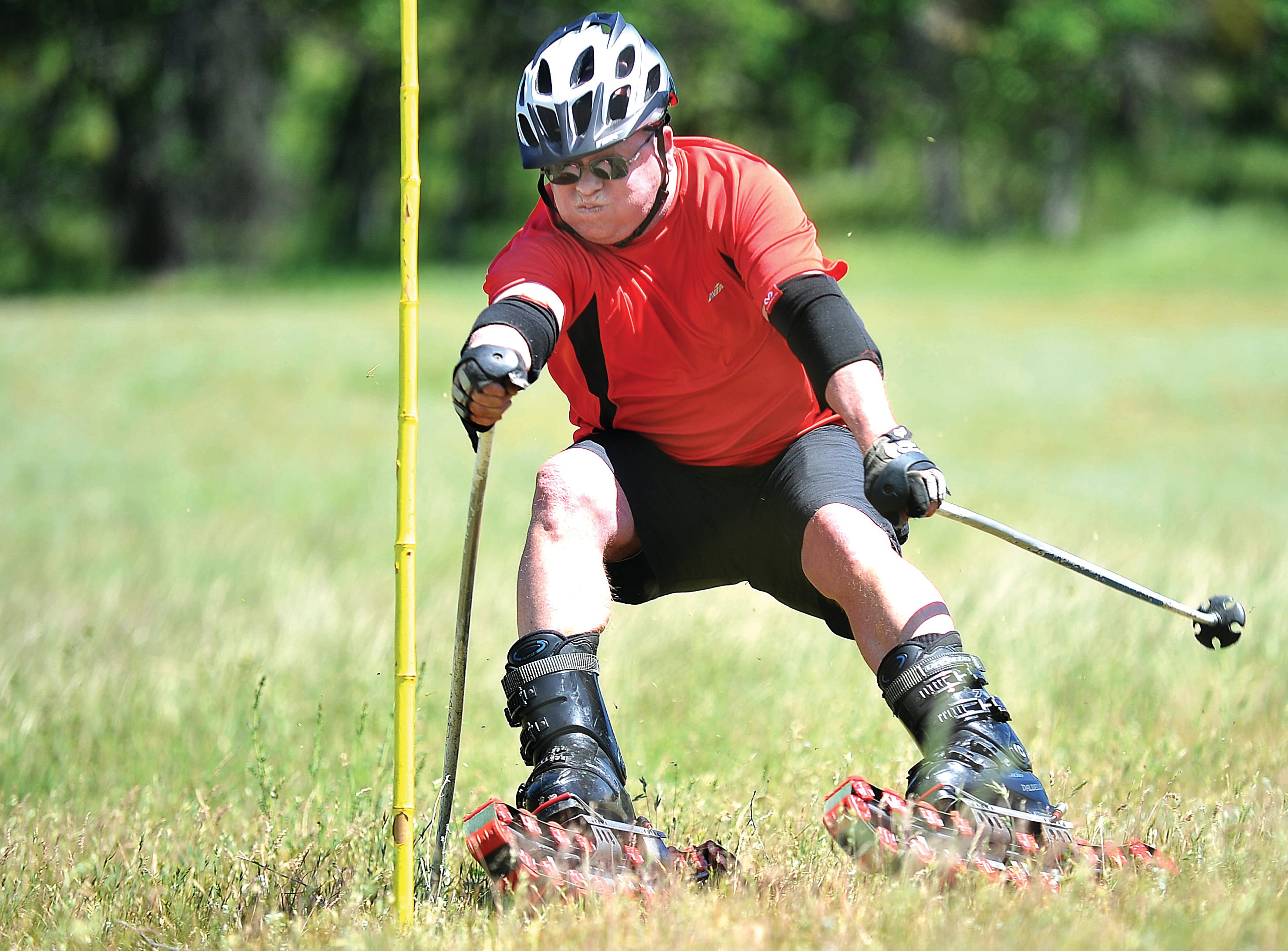Brian McKay deftly slices his way through the slalom gates, planting his poles to carve his downhill turns until one of his skis catches an edge and he spirals off course.
Instead of a face full of snow, the 54-year-old Medford man gets a little dirt on his face and a raspberry on his left leg just below his shorts.
“It’s just like sliding into home plate,” McKay says. “No big deal.”
That’s the crash landing McKay occasionally gets while grass skiing, one of the world’s nichiest of niche sports, and one that he wants to introduce to other Southern Oregon extreme-sports enthusiasts. He’s offering a crash course for anyone who wants to join him on a grassy hanglider’s hill above Emigrant Lake east of Ashland.
Anyone interested in this extreme sport of a past generation can test-drive it by borrowing one of his two extra sets of grass skis, short runners with wheeled, well oiled, tank-like treads strapped to standard downhill ski boots, and give it a shot.
Even better would be a few landowners around the Rogue Valley willing to let McKay bomb down their big hills once they stop laughing at the concept. He can be reached at 541-531-9157.
“I haven’t even come across anybody who even knows what it is,”? says McKay, a 25-year grass-skiing veteran who has a few ski-bum film credits to his name. “But I think there are more people out there now willing to try it, once they’ve heard about it.
“I want some ski buddies. And a hill.”
Grass skiers trace their roots to Germany in the 1960s, when downhill snow-ski racers devised these terrestrial contraptions for summer training regimens. It was introduced to sporting crowds in Europe, then emigrated to the eastern United States and into the San Francisco Bay Area in the late 1970s.
That’s where some friends in 1979 stumbled upon a grass-ski race and thought the mix of excitement and risk was worth trying.
They convinced McKay, who had snow-skied only once in his life, to join them. They rented grass skis at a Santa Cruz surf shop and started careening down whatever hills they could get on.
Later that year, McKay was part of a small contingent of grass skiers who traveled to San Diego for a race. He placed second, and a passion was born.
In 1983, he traveled to Australia as part of the U.S. Grass Skiing Team, which opened the door to what little fame this odd corner of the skiing genre could bring.
“We were in a Japanese potato chip commercial we never saw,” McKay says. “And there was “Ski Country,” a Warren Miller documentary, is the skier’s version of surfing’s “Endless Summer.”
In it, McKay and his friends ski long hills, slaloming through trees and catching air on jumps during a segment that still gets some online love as a YouTube classic clip.
“I like to say I was extreme when they spelled it with an E,”? McKay says.
But a subsequent segment on the television show “That’s Incredible”? all but sealed grass skiing’s future, McKay says. The segment showed wild and apparently painful crashes, relegating legit grass gliders into the freak-show corner of skiing.
“After that, people said, ‘You grass skiers are nuts,”’? he says.
McKay ended up marrying an Australian he met during the world championships and lived in his adopted country until he moved to Medford two years ago to help care for his ailing mother.
And he brought his skis, purchased three decades ago for about $120 a pair.
McKay has spent time driving around the region looking for the best grass-skiing hills he can find. The paraglide launch on the western bank of Emigrant Lake is the best public-access slope he has found so far.
He walks the hill first, putting little flags over squirrel holes. He can ski over them fine, but the dirt clogs the gears he laboriously oils before his day’s runs.
McKay also sets up his slalom course — his gates are actually bamboo sticks he’s painted and flagged.
Snow skiers typically have a slightly tougher time picking up grass skiing because there is no gliding or sliding over dirt.
The skis have to carve, but they leave no trace in the grass and dirt.
Catch an edge and there’s little time for recovery.
“There’s a little bit of risk in it,” McKay says. “That’s what makes it fun. It’s not something you master the first time out.”
And there’s no snow-plowing on dirt, either.
“The only thing you can’t control is your speed,” McKay says. “You just go faster and faster until you run out of hill or reach terminal speed.”?
In order to grow beyond the what-the-hell-is-that-guy-doing stage, the sport needs an actual ski park, McKay says.
He’s tried it a few times, but the ventures failed in part because skiers need a chair lift to ferry them uphill between runs.
And it would help if the ground got a little softer.
“You need a major investment,”? McKay says. “Nobody wants to walk up the hill, and it hurts to fall. It’s not like falling on snow.”




